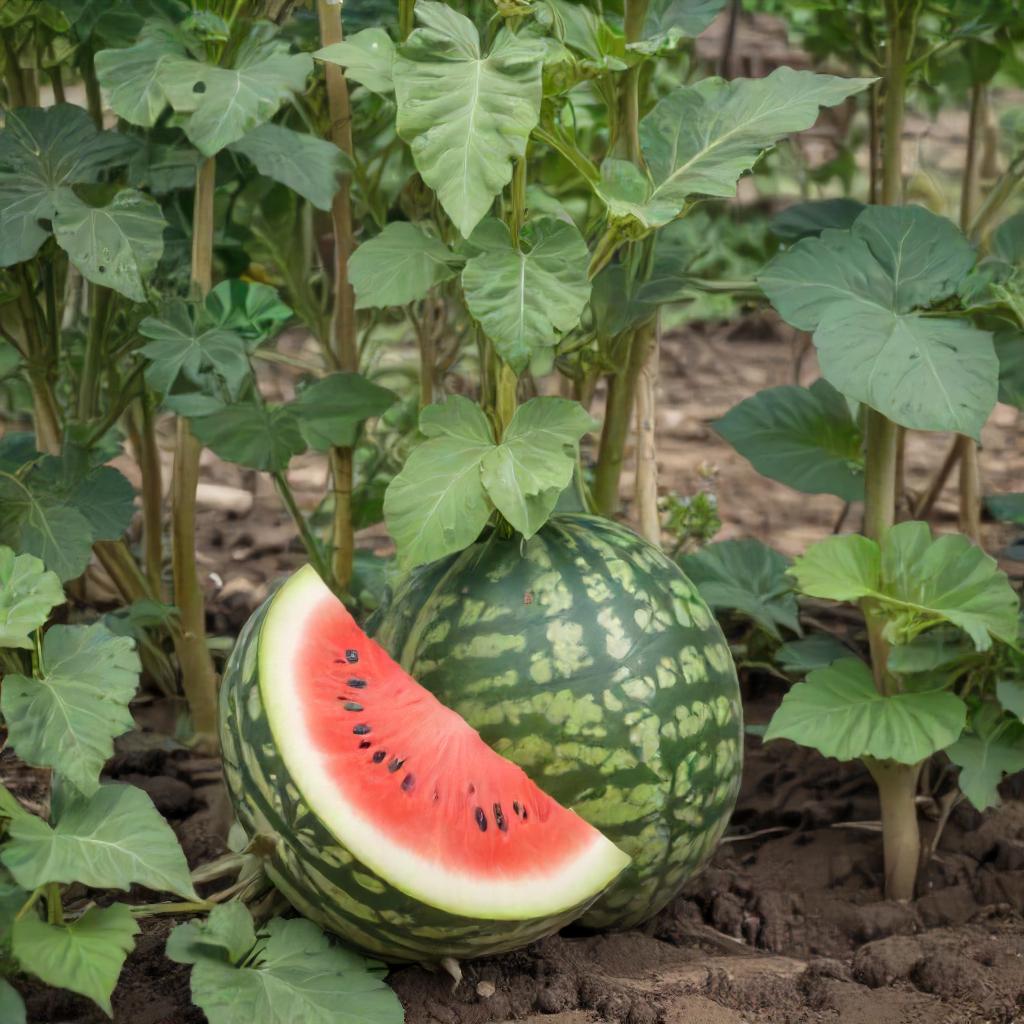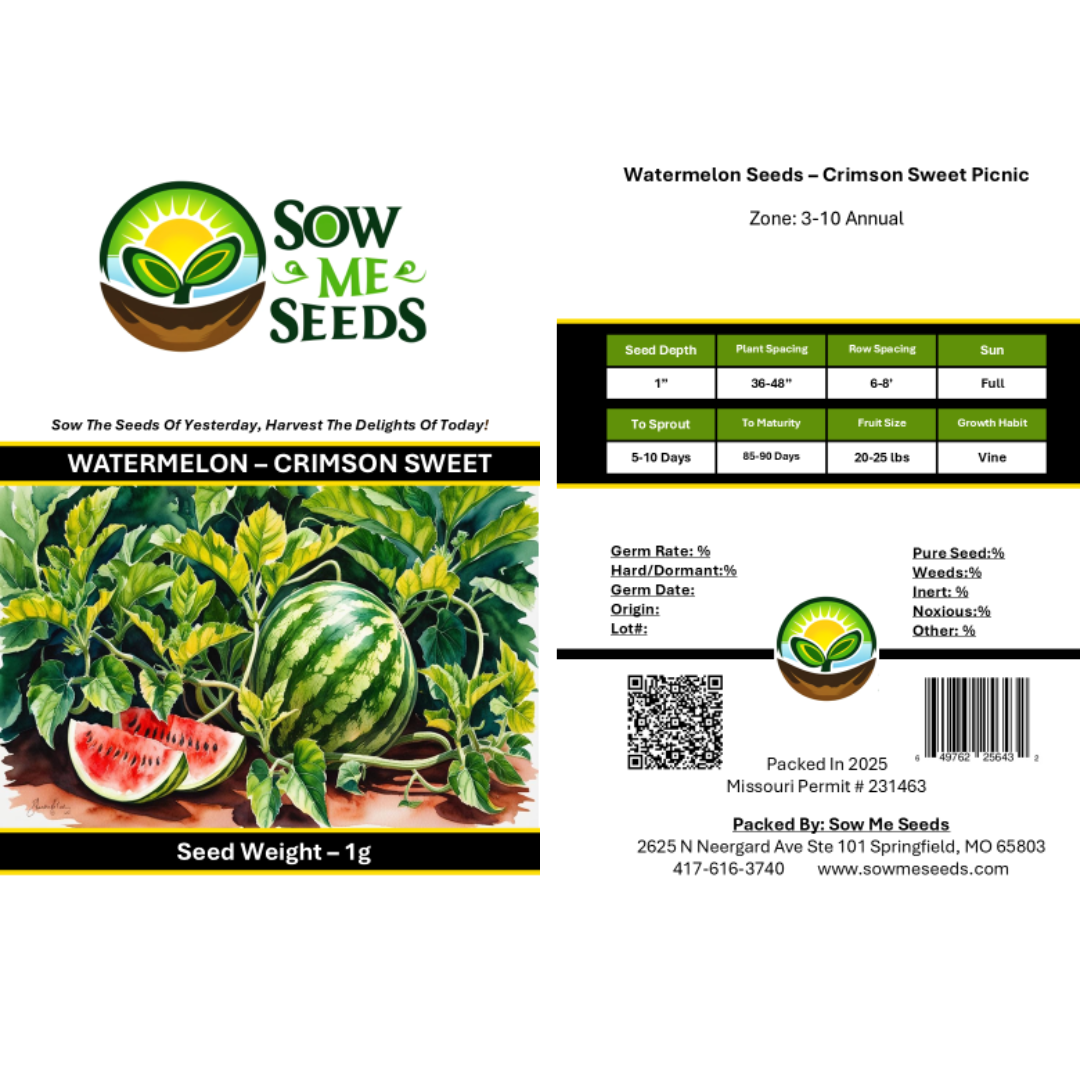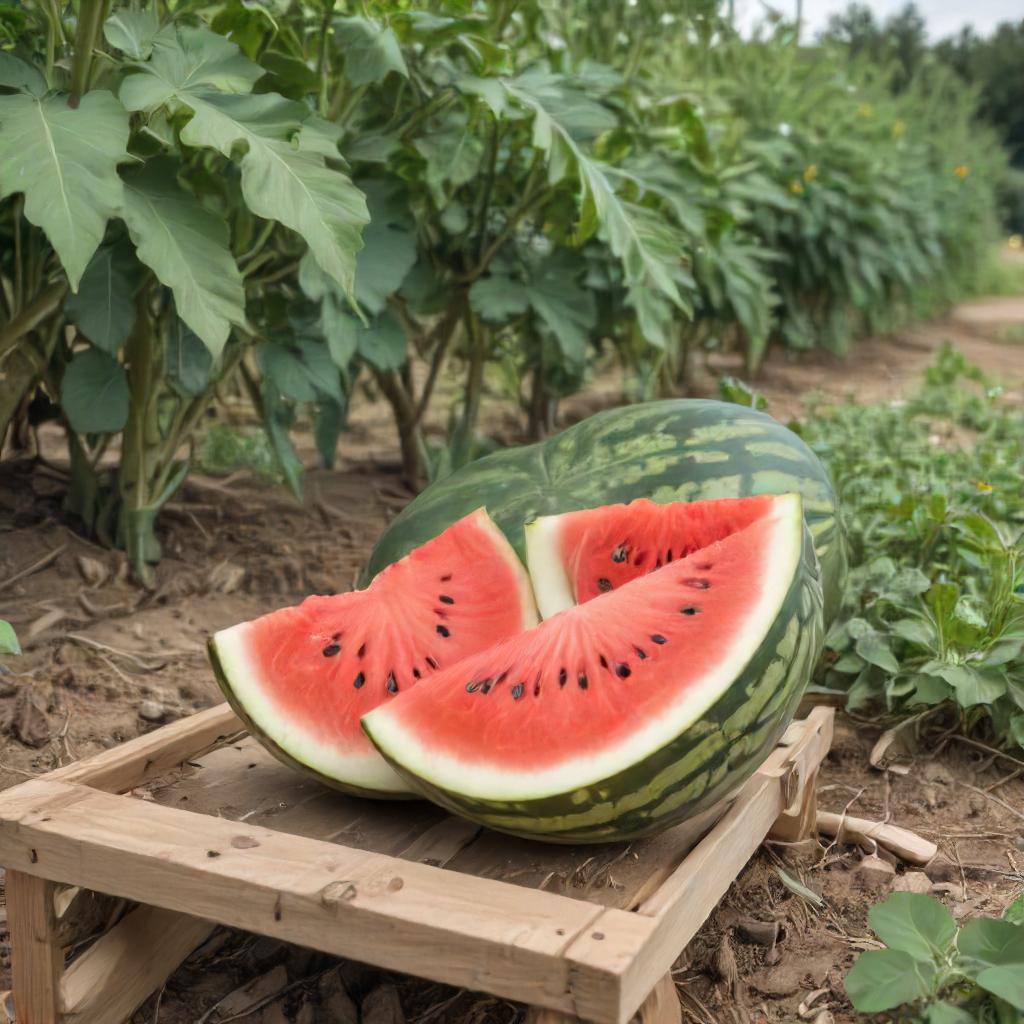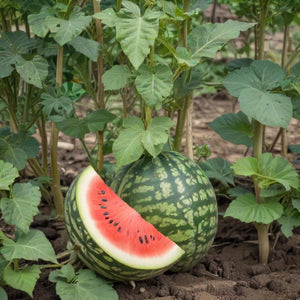- Hardiness Zone: 3-10 Annual
Seed Depth: 1 inch
Seed Spacing: 36 inches
Row Spacing: 6–8 feet
Sunlight: Full sun
Days to Sprout: 7–10 days
Days to Maturity: 80–90 days
Growth Habit: Spreading Vine
Sunlight: Choose a location that receives full sun for at least 8-10 hours a day. Watermelons thrive in warm, sunny conditions.
Soil: Prefers well-drained, sandy, or loamy soil with a pH between 6.0 and 7.0. Amend the soil with compost or well-rotted manure to enhance fertility and drainage. Watermelons are heavy feeders, so nutrient-rich soil is essential for optimal growth.
When to Plant: Watermelons are warm-season crops that should be planted after the danger of frost has passed and the soil has warmed to at least 70°F (21°C). In cooler climates, you can start seeds indoors 3-4 weeks before the last frost date and transplant them outdoors after the soil has warmed.
Direct Sowing: Sow seeds directly in the garden 1 inch deep in hills spaced 3-4 feet apart. Plant 4-6 seeds per hill and thin to the 2-3 strongest seedlings once they are a few inches tall.
Transplanting: If starting indoors, transplant seedlings outdoors when they have 2-3 true leaves and the soil has warmed.
Succession Planting: Stagger plantings every 2–3 weeks to enjoy a prolonged harvest.
Watering: Keep the soil consistently moist but not waterlogged. Watermelons need plenty of water during the growing season, especially during flowering and fruit development. Water at the base of the plant to avoid wetting the foliage, which can lead to disease. Reduce watering slightly as the fruit begins to ripen to enhance sweetness.
Fertilization: Watermelons are heavy feeders. Apply a balanced fertilizer or compost at planting time. Side-dress with a nitrogen-rich fertilizer when the plants are about 6 inches tall, and switch to a phosphorus and potassium-rich fertilizer when the plants start to flower.
Mulching and Weeding: Apply a layer of mulch around the plants to retain soil moisture, suppress weeds, and keep the soil temperature consistent. Mulch also helps protect developing melons from soil contact, which can cause rot. Hand-pull weeds carefully to avoid disturbing the shallow roots of the watermelons.
Training and Space Management: Watermelons are vining plants that require ample space to spread. If space is limited, consider using trellises to train the vines vertically, but ensure the trellis is sturdy and provide support for the heavy fruits as they develop.
Pest and Disease Management: Watermelons can be susceptible to pests such as aphids, cucumber beetles, and squash bugs. Use organic pest control methods like neem oil, insecticidal soap, or hand-picking to manage infestations. Practice crop rotation and ensure good air circulation to prevent fungal diseases like powdery mildew.
When to Harvest: Crimson Picnic Watermelons are typically ready to harvest 80-85 days after planting. The best indicator of ripeness is when the tendril closest to the fruit has dried and turned brown, and the underside of the melon (where it touches the ground) has turned a creamy yellow color.
How to Harvest: Use a sharp knife or pruning shears to cut the watermelon from the vine, leaving a short stem attached. Handle the fruit gently to avoid bruising.
Storing Fresh Watermelon: Whole watermelons can be stored at room temperature for about a week. Once cut, watermelon should be stored in the refrigerator, covered, and consumed within 3-5 days.
Why You’ll Love It
Sweet and Juicy: Packed with classic watermelon flavor — crisp, refreshing, and extra juicy.
Perfect Picnic Size: Fruits average 15–25 pounds — ideal for gatherings, BBQs, and summer treats.
Disease Resistant: Strong resistance to anthracnose and fusarium wilt for healthier, more reliable harvests.
Classic Appearance: Deep red flesh with dark and light green striped rind — a true summer staple.
Plant Characteristics
Vine Length: 6–10 feet
Growth Habit: Vigorous, sprawling vines with broad leaves
Fruit Type: Oval-shaped with striped rind and bright red interior
Fruit Size: 15–25 pounds
Days to Maturity: 80–90 days
Hardiness: Warm-season annual
Flavor and Culinary Uses
Flavor: Exceptionally sweet and juicy with firm, crisp texture
Culinary Uses: Enjoy fresh in slices, fruit salads, smoothies, or chilled for a hydrating summer snack
Companion Planting Tips
Good Companions: Corn, marigolds, nasturtiums, and radishes
Avoid Planting Near: Cucumbers or other melons to prevent cross-pollination
Bonus Benefit: Dense vines shade the soil and help suppress weeds naturally
Common Issues and Solutions
Fruit Cracking: Keep watering consistent, especially after dry spells, to avoid sudden swelling
Powdery Mildew: Provide airflow and use organic fungicides if needed
Poor Pollination: Attract pollinators or hand-pollinate early flowers for best fruit set
Seeds Per Packet
| 1g | Approximately 21 |
| 5g | Approximately 105 |
Why You’ll Love It
Sweet and Juicy: Packed with classic watermelon flavor — crisp, refreshing, and extra juicy.
Perfect Picnic Size: Fruits average 15–25 pounds — ideal for gatherings, BBQs, and summer treats.
Disease Resistant: Strong resistance to anthracnose and fusarium wilt for healthier, more reliable harvests.
Classic Appearance: Deep red flesh with dark and light green striped rind — a true summer staple.
Plant Characteristics
Vine Length: 6–10 feet
Growth Habit: Vigorous, sprawling vines with broad leaves
Fruit Type: Oval-shaped with striped rind and bright red interior
Fruit Size: 15–25 pounds
Days to Maturity: 80–90 days
Hardiness: Warm-season annual
Flavor and Culinary Uses
Flavor: Exceptionally sweet and juicy with firm, crisp texture
Culinary Uses: Enjoy fresh in slices, fruit salads, smoothies, or chilled for a hydrating summer snack
Companion Planting Tips
Good Companions: Corn, marigolds, nasturtiums, and radishes
Avoid Planting Near: Cucumbers or other melons to prevent cross-pollination
Bonus Benefit: Dense vines shade the soil and help suppress weeds naturally
Common Issues and Solutions
Fruit Cracking: Keep watering consistent, especially after dry spells, to avoid sudden swelling
Powdery Mildew: Provide airflow and use organic fungicides if needed
Poor Pollination: Attract pollinators or hand-pollinate early flowers for best fruit set
Seeds Per Packet
| 1g | Approximately 21 |
| 5g | Approximately 105 |





Share and get 15% off!
Simply share this product on one of the following social networks and you will unlock 15% off!